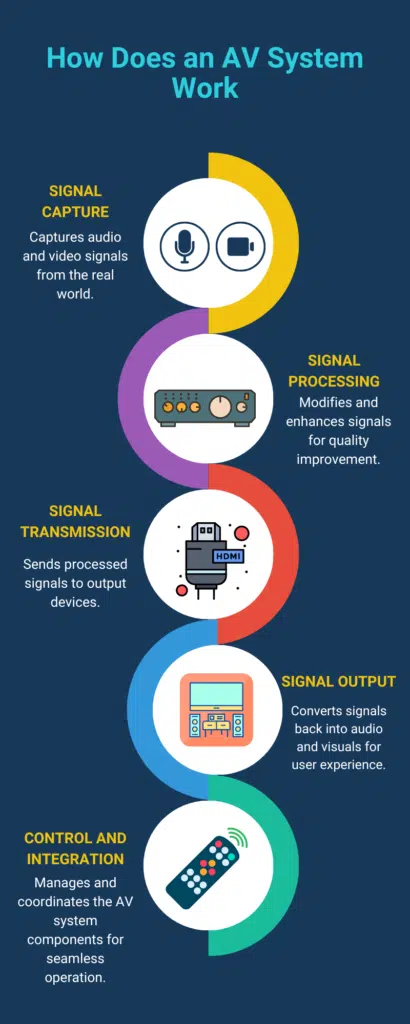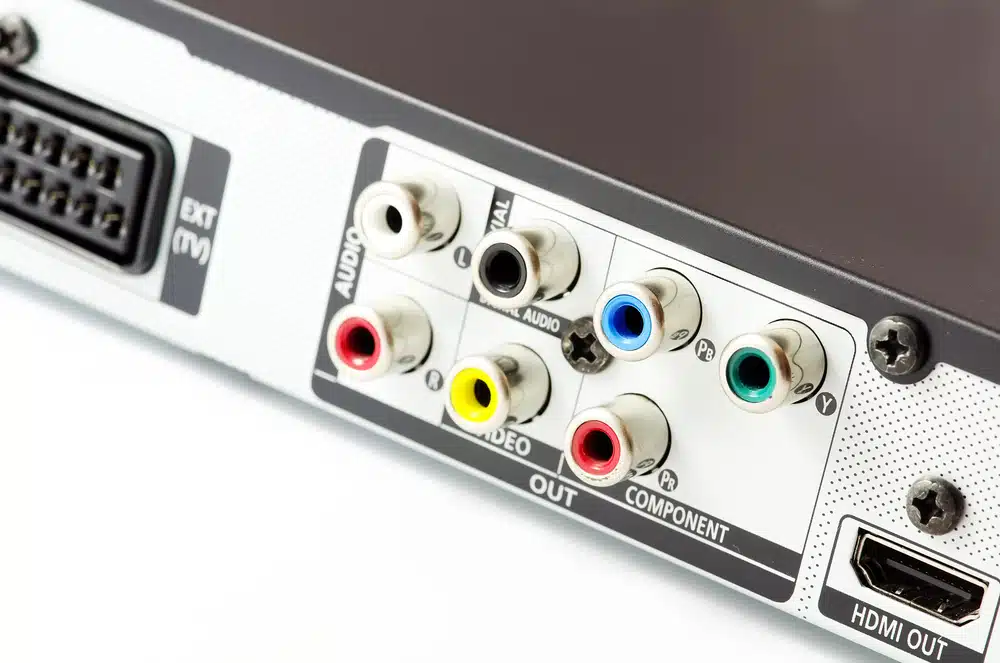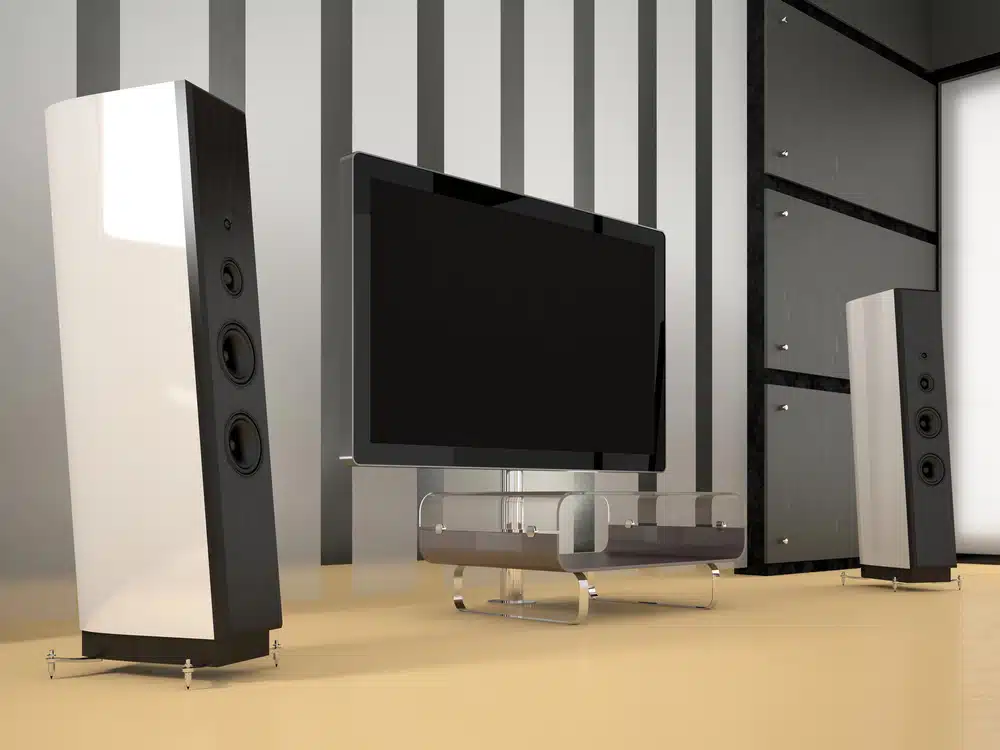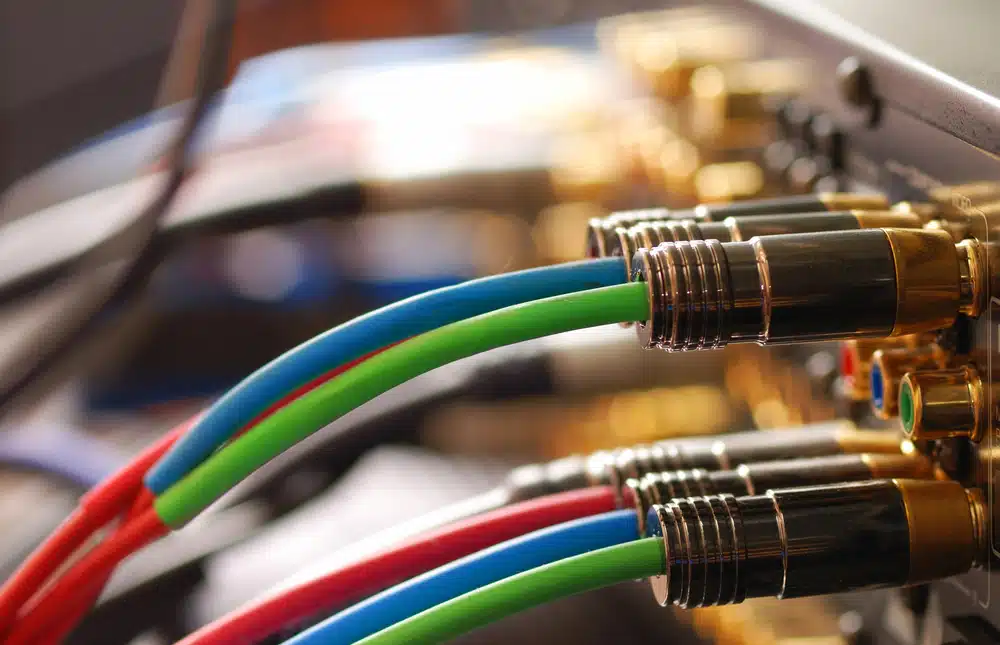In today’s fast-paced digital world, the struggle to maintain high-quality audiovisual experiences can be a real challenge. Whether it’s a glitchy video call or a home theater system that just doesn’t live up to expectations, the need for reliable AV solutions has never been more apparent. This brings us to a crucial question: how does an AV system work? Understanding the mechanics behind audiovisual systems is the first step towards solving these common issues.
This blog post aims to explore the basics of AV systems, breaking down their key components and functionalities. By providing a clear understanding of how these systems operate, we hope to equip you with the knowledge needed to enhance your audiovisual experiences, making them smoother and more enjoyable.
How Does an AV System Work
At the heart of understanding an AV system is grasping the five key aspects that define its operation. These components work together to capture, process, and output audio and video signals, ensuring a seamless experience for users.

Signal Capture
The first step in an AV system’s operation involves capturing audio and video signals. This is achieved through devices such as microphones and cameras. These devices convert real-world sounds and images into electronic signals that can be processed by the AV system.
- Microphones capture sound waves and convert them into electrical signals.
- Cameras capture light and convert it into video signals.
Signal Processing
Once captured, these signals often require modification or enhancement to meet the desired quality. Signal processing can include amplifying audio signals, compressing video for efficient transmission, or converting formats for compatibility purposes.
- Amplifiers increase the strength of audio signals.
- Video encoders compress and format video signals for display or streaming.
Signal Transmission
Transmission involves sending the processed signals to the output devices. This can be done through wired connections like HDMI cables or wirelessly via technologies such as Bluetooth or Wi-Fi.
- HDMI cables transmit high-definition video and audio signals.
- Wireless transmitters allow for flexible placement of speakers and displays.
Signal Output
Output devices are the end points of an AV system, where the signals are converted back into sounds and images for the user to experience. This includes speakers for audio and screens for video.
- Speakers convert electrical signals back into sound waves.
- Displays convert video signals into visible images.
Control and Integration
Finally, control systems and integration tools allow users to manage and coordinate the various components of their AV system. This can range from simple remote controls to complex software that integrates multiple AV inputs and outputs for a seamless user experience.
- Remote controls offer basic functions like volume adjustment and source selection.
- AV integration systems enable the centralized control of complex setups, combining inputs from multiple sources and directing them to the appropriate output devices.
Understanding these key aspects sheds light on the query, “how does an AV system work,” providing a foundation for optimizing any audiovisual setup. Whether setting up a home theater or configuring a boardroom for video conferences, recognizing how these components interact can significantly improve your AV experience.
What Are the Devices in an AV System?
Exploring the devices that constitute an AV system is pivotal in comprehending the full scope of how these systems operate. These devices not only capture and display content but also process and control the signals to ensure optimal performance. Understanding the variety and function of these devices will illuminate further how an AV system works, offering insights into customizing and enhancing your audiovisual experiences.
Audio Devices
Audio devices are the cornerstone of any AV system, ensuring that sound is captured, enhanced, and delivered with clarity.

- Microphones – These devices are the initial point of audio input, capturing sound waves from voices or instruments. Depending on their design, microphones can pick up sound from specific directions or more broadly, making them versatile for various settings.
- Mixers – By adjusting levels, adding effects, and combining signals from multiple microphones or audio sources, mixers allow for the creation of a balanced and harmonious sound output. This flexibility is crucial in settings where audio from various sources must be blended smoothly.
- Amplifiers – Serving as the powerhouse of the audio system, amplifiers take the processed audio signals and boost their strength to drive speakers effectively. This ensures that the sound is loud enough to reach the audience, without distortion.
- Speakers – The final step in the audio path, speakers translate electrical signals back into audible sound waves. The quality and placement of speakers greatly influence the listener’s experience, highlighting the importance of choosing the right speakers for the environment.
Video Devices
The visual components of an AV system play a pivotal role in engaging the audience and delivering visual content.
- Cameras – Essential for live events, lectures, and conferences, cameras capture real-time video. The technology behind cameras, including resolution and frame rate, determines the clarity and smoothness of the captured video.
- Video Switchers – These devices allow for seamless switching between video sources, such as cameras, computers, and media players. This is particularly important in presentations or broadcasts where multiple video inputs need to be displayed in sequence or simultaneously.
- Projectors and Screens – For large audiences, projectors cast video signals onto screens, making the content visible to everyone. The combination of projector brightness, screen size, and ambient light conditions affects the overall visibility of the video.
- Monitors: Often used for personal viewing or in small group settings, monitors provide a direct display for video signals. High-definition monitors offer sharp and clear images, enhancing the viewing experience for detailed visuals.
Control Devices
The ability to manage and integrate the various components of an AV system seamlessly is crucial for its effectiveness.
- Remote Controls – These wireless devices simplify the operation of AV systems, allowing users to adjust settings such as volume, input sources, and playback from a distance. This convenience is key in environments where flexibility and quick adjustments are necessary.
- Control Processors – Acting as the central hub, control processors automate complex tasks and coordinate the operation of various AV components. Through programming, they can execute scenarios like dimming lights when a video starts or changing audio sources automatically.
- User Interfaces: Whether it’s a touch panel in a conference room or a mobile app for home entertainment, user interfaces provide a direct way for users to interact with their AV system. Intuitive design and customization options make it easier for users to access and control their audiovisual content.
In exploring these devices, it becomes evident how each plays a specific role in ensuring that an AV system operates smoothly and efficiently. Understanding the functions and interplay of these devices can significantly enhance one’s ability to optimize and troubleshoot their system, ultimately answering the question of how does an AV system work in a practical, real-world context.
What Does AV Design Mean?
AV design encompasses the strategic planning and integration of audiovisual systems to meet specific user needs and spaces. It involves selecting the right combination of devices, ensuring they work together seamlessly, and configuring them to deliver the best possible audio and video quality. Whether for a home theater, a corporate boardroom, or an educational lecture hall, effective AV design is key to creating an engaging and efficient audiovisual environment. Let explore the essentials of AV design and when to seek professional expertise, furthering the understanding of how an AV system works.
Importance of Custom AV Design

Custom AV design tailors the audiovisual system to the unique requirements of the user and the physical characteristics of the space. This personalized approach ensures that the system not only meets the current needs but also is scalable for future requirements. Key considerations include:
- Room Acoustics – Understanding the room’s acoustics is vital for placing speakers and microphones to minimize echoes and ensure clear sound.
- Visual Needs – Depending on the audience size and room layout, the size and placement of displays are adjusted to ensure optimal visibility.
- System Compatibility – Ensuring all components are compatible and can communicate effectively to avoid any performance issues.
When to Call a Professional
While some AV setups can be done independently with basic knowledge, certain scenarios necessitate professional expertise:
- Complex Environments – Large or acoustically challenging spaces require sophisticated designs that account for sound propagation and visual considerations.
- Integrated Systems – When the AV system needs to work with other systems (e.g., lighting, security), professional integration ensures smooth operation.
- High-End Customization – For those seeking advanced features, such as automation or custom-built solutions, professional designers can provide tailored options not available off-the-shelf.
Professional AV design not only optimizes the audio and visual experience but also ensures the system is user-friendly and reliable. By involving experts, users can avoid common pitfalls and ensure their system is set up for success from the start.
As part of understanding how an AV system works, recognizing when to leverage professional AV design services can significantly enhance the outcome of any audiovisual project.
Final thoughts
As we’ve explored the key components and considerations in designing and utilizing an AV system, it’s clear that understanding how an AV system works is crucial for anyone looking to create an immersive and effective audiovisual experience. Whether it’s selecting the right mix of devices, understanding their roles within the system, or recognizing when professional design expertise is needed, each aspect contributes significantly to the overall performance and satisfaction derived from using AV technology.
Custom Integrators is the answer for those seeking to enhance their spaces with the latest in AV solutions. Our commitment to quality, coupled with a deep understanding of the intricacies of AV systems, allows us to offer unparalleled service and support. From the initial design phase to the final installation, we ensure that your audiovisual system not only meets but exceeds your expectations, answering the pivotal question: how does an AV system work?
Whether for personal enjoyment, educational purposes, or professional advancement, understanding and leveraging the power of audiovisual technology can dramatically enhance your experience. With Custom Integrators, navigating the complexities of AV systems becomes a seamless and rewarding journey, ensuring that your audiovisual needs are met with expertise and precision.

